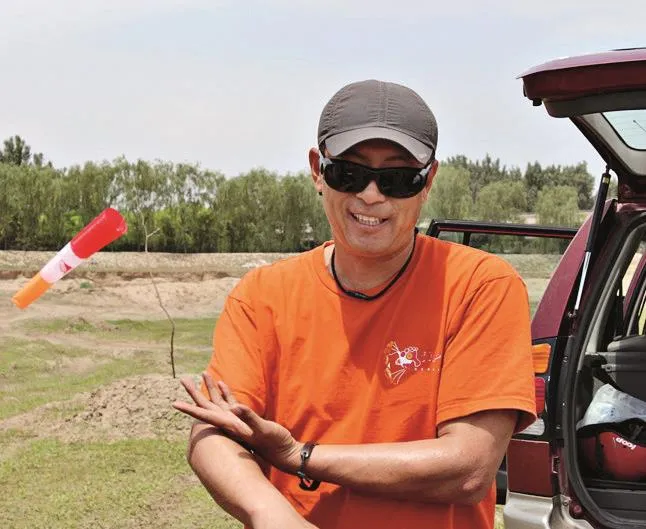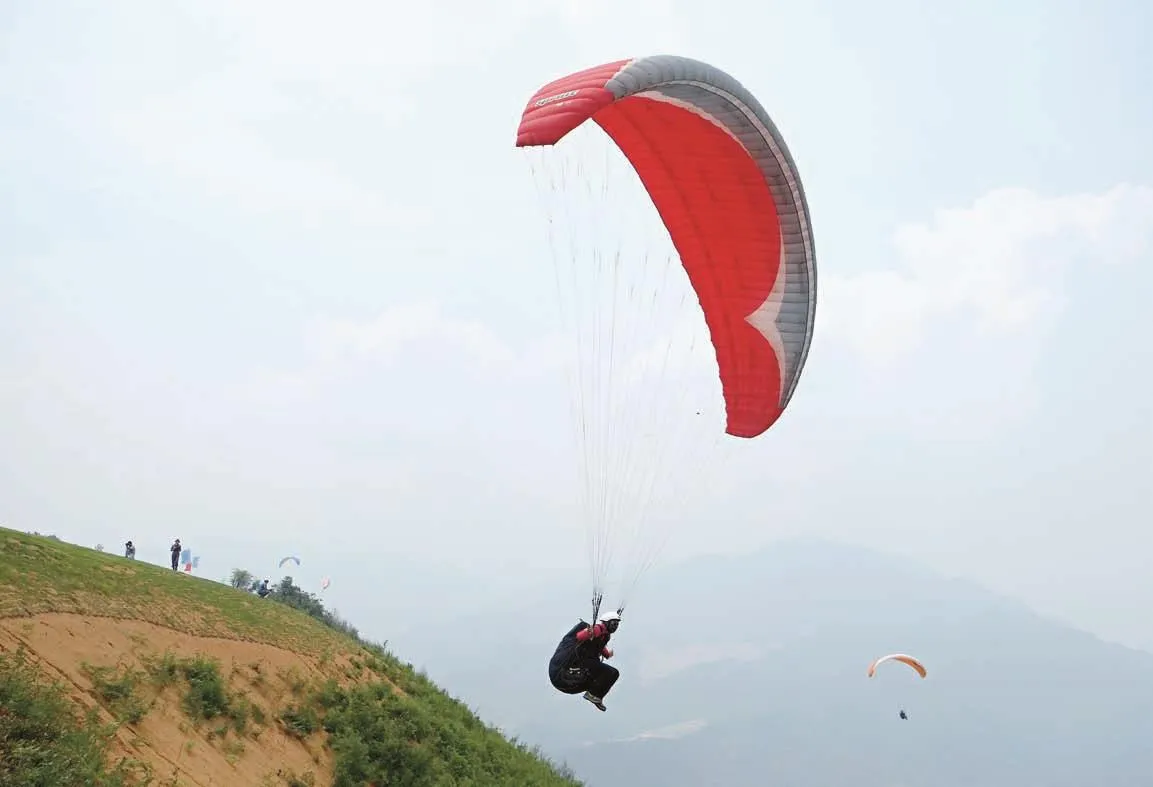CRACKS IN THE GREEN WALL
2013-08-02BYOLIM
BY K A I T L I N S OL IM I N E
CRACKS IN THE GREEN WALL
BY K A I T L I N S OL IM I N E


SANDSTORMS
Desertification threatens to engulf northern China
“三北防护林”真的可以成为北方的“绿色长城”吗?
It’s a typical spring scene in Beijing; northerly winds rattle windows, dust smatters roof tops, cars, and pedestrians. Walk outside and you’re bombarded with tiny sand particles that cling to your eyes and crunch between your teeth.
For centuries in northern China, these annual sandstorms, called the Yellow Dragon, have been ripping through the city. Experience just one and you’ll know why. They roar through the city, upending construction sites and raining yellow sand on everything in their path. The largest storms can be seen from space as huge brown plumes moving from northwest China and Mongolia to blanket much of northeast Asia.
A 2005 paper in the journal Nature noted that between the fourth century and 1949, northeastern China saw a dust storm on average every 31 years. After 1990, the study reports, the average jumped to one per year. Nowadays, the average rate of dust storms for the Beijing region in northeastern China can be upwards of five or six a year.
UNDERLYING SUCH A MASSIVE LONG-TERM AND NATIONWIDE PROGRAM IS THE IDEA THAT HUMANKIND CAN SHAPE AND CONTROL NATURE, A PHILOSOPHY POSSIBLY STEMMING FROM MAO-ERA POLICIES
Desertification in China is a growing problem and is the cause of the increased frequency of storms. According to a 2006 report filed by the China National Committee for the Implementation of the United Nation’s Convention to Combat Desertification (UNCCD), the area prone to desertification in China is 3.317 million square kilometers large, accounting for 34.6 percent of total territory.
In 1978, with such an expanse of Chinese land either naturally desert or prone to desertification, the Chinese government established a formal campaign to address such threats.
Their cure-all solution? The Green Wall of China, also known as the Three-North Forest Shelterbelt Program (三北防护林体系工程 Sān-Běi fánghùlín tǐxì gōngchéng). It’s a 3000-mile tree belt stretching from far western Xinjiang to Heilongjiang in the northeast. According to University of Hawaii Professor of Geography Hong Jiang, the program aims to establish 35.6 million hectares of protective forests over a swath of 2,783 miles in northeast, north, and northwest China. The program is slated to take 73 years (finishing in 2050) and raise forest coverage in northern China from five to 15 percent. Others cite goals of upwards of 42 percent forest coverage.
The UNCCD reported in 2006 that the government’s intermediate objective within 10 years is to keep 20 million hectares of desertified land under control, establish 1.2 million hectares of the shelterbelt system, and enclose 11 million hectares of sandy land for forest and grassland regeneration.
Underlying such a massive long-term and nationwide program is the idea that humankind can shape and control nature, a philosophy possibly stemming from Mao-era policies. As early as 1940, Mao gave a speech at the inaugural meeting of the Natural Science Research Society of the Border Region, discussing his ideas about the relationship of man and nature. He said, “For the purpose of attaining freedom in the world of nature, man must use natural science to understand, conquer, and change nature and thus attain freedom from nature.”
China’s history of programs to “conquer nature” have hitherto included cloud seeding prior to the Olympic Games and widespread dam projects, such as the controversial Three Gorges Dam. It could be said that the Green Wall of China forms the backbone of a pervasive philosophy that humankind is more powerful than nature.
But, there are cracks in the wall.
The logistics of the Green Wall have required massive mobilization of local officials and villagers. Most of the areas impacted by the program are rural, often asking farmers or ranchers to turn their attention to re-envisioning both the local environment and their livelihoods. There are stipulations in these areas for locals to participate in a number of tree planting days each year, according to Professor Jiang.
Furthermore, the program’s widespread tree planting campaigns typically allot only one or two species of tree to an area. Professor Jiang wrote in a 2009 Epoch Times article, “In Ningxia, for example, 70 percent of the trees planted were poplar and willow. In 2000, one billion poplar trees were lost to a disease (Anoplophora), wiping out 20 years of planting efforts.” At the same time, there has been an emphasis on creating fenced-in grassland for livestock pastures, especially in areas of Inner Mongolia previously open to nomadic ethnic Mongolians.
While the campaign sounds like a necessary one, the nuances of transforming such vast areas of habitat are much more complicated. For one, Professor Jiang notes that theproject is not an anti-desertification or reforestation program as much as one of “afforestation”. Forests are not being grown in places they once proliferated, but rather in long-barren regions. Because of this, many planted forests do not survive due to the fact they don’t receive sufficient rainfall or maintain suitable soil conditions.
The use of single species as well as crowded planting complicates the survival of the forests. According to a World Resource Institute Report, of the 53,000 hectares of trees planted in Gansu’s Minqin area in the last few decades, a quarter of the seedlings have died and the rest are dwarf trees, lacking any capacity to protect the soil.
Due to the increasing inefficiencies of the program, Chinese scientists are voicing their concerns about the headstrong pursuit of the Three-North Forest Shelterbelt program.
In recent decades, the most vocal critic has been prominent ecologist Jiang Gaoming from the Chinese Academy of Sciences.
“Planting trees in arid and semi-arid land violates [ecological] principles,”Jiang said to reporters of Chinese Flowers News. He called the goal of raising forest cover to 15 percent in northern China a “fairytale”.
Similarly, as early as 2003, scientists Zhang Lixiao and Song Yuqin of Beijing University’s Department of Environmental Sciences wrote a paper on the inefficiencies of the Three-North Forest Shelterbelt Program. They noted the program has not achieved its stated defensive purpose and that it must be reexamined in light of new water demands, population pressures, ecological principles, and market rules.
Professor Jiang of the University of Hawaii echoes these concerns. In her research in Inner Mongolia in the early 2000s, she spoke with a local government leader who complained that despite the great effort his county made, the planting area had to be covered twice due to failing forests—and they still couldn’t make national quotas. He blamed the weather and the lazy locals.

Dead willow seedlings on the Ordos Plateau in Inner Mongolia
A QUARTER OF THE SEEDLINGS HAVE DIED AND THE REST ARE DWARF TREES, LACKING ANY CAPACITY TO PROTECT THE SOIL
But Professor Jiang disagrees with him. She says, “I was thinking it should be human beings cooperating with the climate, rather than the other way around.”
The larger picture of desertification in China is impacted by shrinking water tables (said to reach “dire” levels in 30 years), a lack of arable land, population growth, and record-level water and air pollution. In areas like Inner Mongolia, the expansive environmental engineering of the Green Wall has dramatically upended a traditionally nomadic lifestyle by fencing in pastures.
Dan Dong, a Ph.D. student in Geography and Geographic Information Science at the University of Illinois at Urbana-Champaign, conducted fieldwork on desertification of Inner Mongolia’s grasslands. Dong believes scientists are doing what they can to provide answers to the desertification issues, but more practical plans are needed.“These plans should be based on scientific experiments, should be suitable to the local situation, and should reflect the opinions of community members,” Dong says.“We need to import new ideas and thoughts, learn from successful cases, and ground the plans according to more advanced scientific technology, instead of just using old methods.”
What, therefore, is the solution to the desertification crisis? How can China’s Great Green Wall be amended to address the new and unanticipated climate concerns of the modern era? In general, Professor Jiang believes the government is currently in the mode of merely responding to environmental crises rather than preventing them. Such large-scale and publicized events like air pollution force the government into action. Such a model, says Jiang, shows the possibilities for addressing urban industrial environmental pollution but doesn’t properly address environmental concerns in rural areas, including the overdrawing of ground water and the tremendous human effort placed on tree planting campaigns.
Despite such calls for amended action, the government’s plan is still to plant more trees, a simplistic method that, according to scientists like Jiang Gaoming and Professor Jiang, will not cure the country’s desertification problems.
Ph.D. student Dong believes part of the issue stems from a lack of education. “People must know that our environment is getting worse, and we need to protect it and improve it,” Dong says. “I think there are many people who don’t even know this, and that’s very sad.”
Professor Jiang agrees. “It works rhetorically to help urban people think the government is doing something, but ecology is a very complicated issue that requires more than one simple method that can treat all ills,” she says. “The Great Green Wall still generates a lot of positive buzz in all of China. But a lot of subtleties are not discussed. I think if they were discussed, people would be able to understand it easily. After all, it’s not rocket science.”

Despite some successful plantings, the Great Green Wall is failing to keep out the desert
SUCH LARGE-SCALE AND PUBLICIZED EVENTS LIKE AIR POLLUTION FORCE THE GOVERNMENT INTO ACTION

Zhao Meiyuan is silent. His tanned, weathered face points upwards to the sky, brows knit in concentration. He is concerned with one thing: wind speed on the outskirts of Beijing in Chaobaihe (潮白河), one and a half hour drive outside the Fourth Ring Road. No more than six meters per second is the rule, so today is a go.
Zhao Meiyuan, or Dollar Zhao as he is known in English, is the founder and chief coach at Super-Wing Paragliding Club (大羽滑翔伞俱乐部 Dàyǔ Huáxiángsǎn Jùlèbù) in Beijing. For each day of flying, he or his coaches go through the checklist of safety measures to ensure that paragliders, or pilots, are not exposed to more risk than one would expect hundreds of meters above the ground attached to a parachute.
Wind speed, check. Temperature, not more than a 12 degrees Celsius difference in a single day, check. Equipment, check.
When the coaches give the go-ahead, everyone heads for Chaobaihe.
Once there, Hebe Hua waits for her turn to practice raising the parachute vertically under Zhao’s tutelage. She wears a floppy, black fisherman’s hat and army fatigues that are a couple of sizes too large, but she has a big smile on her face. In her mid-twenties, the advertising agency employee is the characteristically overstressed, young urban worker.
“Normal life is too boring and work pressure is very heavy,” says Hua with a sigh. “That’s why we like these extreme sports, it excites us, and makes life more fun,” she says, brightening up.“I’m really looking forward to the next course.”
Flying or dreams of flying do not just appeal to the stereotypically athletic, young adrenaline junkies. In China, pilots come from far-flung corners of the demographic chart—from yuppie CEOs to 60-year-old grandparents. Though, interestingly, Zhao thinks that this will be the sport of choice for women in the future. He believes that this is because of the social pressure young Chinese men face to save money in order to support their families or future families.
“If the girls have some money, it is easy for them to spend this on travel or learning a new skill like paragliding,”he says. “The boys may have to face the pressure of buying a house, mortgage pressure, etc.”
And you certainly need money for this type of hobby.
Zhao’s beginner course costs 8,000 RMB and purchasing your own equipment will set you back about 26,000 RMB. Because there are no paragliding certification requirements or licenses, it is absolutely essential that new pilots train with professionals before attempting to fly.
Liao Yu is a prime example of such spending power. The early-thirties consultant started taking paragliding lessons in 2011 and travels around the world with her equipment, seeking hernext adventure. “I take it with me so I can paraglide when I travel. I bought portable equipment that only weighs 14 kilograms, so it’s easy to carry,” she says, clearly proud of her set.

Dollar Zhao testing the speed and direction of the wind so he can get his students in the air
“I spent this weekend in Linzhou, Henan Province, which is a good place for paragliding, but, for the past year and a half, I’ve flown not only in China, but also in Turkey, France and Spain.”
Not everyone has had such an easy time getting off the ground. For many, flying is just a dream. This was true of 63 year-old Chen Tieguang who chased his dream for decades until his first flight on his 50th birthday.
Chen’s parents were founding members of the Chinese Air Force, so, as a little boy, Chen grew up dreaming of taking to the sky.
Despite the unstable economic environment in China in the 60s and 70s, Chen was also able to enter the Chinese Air Force. “I entered into the Air Force but not as a pilot. I was an engineer on the ground, servicing bombers for nearly 17 years,” he says. Fate put him torturously close to reaching his dreams but unable to fulfil them. “I wanted to fly, but there was no chance. And after I left the Air Force, I was too busy with a new job.”
“THIRTY PERCENT OF THE RISKS ARE NOT CONTROLLABLE, AND YOU CAN NOT PREDICT UNFORESEEN CIRCUMSTANCES”
After five decades of waiting, he finally got his chance. “My first flight was in 1999, in Mang Mountain, in the Beijing Ming Tombs Scenic Area, Changping District, where many people used to practice in the late 1990s. Then, the sky was already filled with parachutes,” he remembers fondly.“That day, in the morning, I trained on the ground for two hours in the afternoon. Then, I tried the small-hill flight, and I finally flew into the sky. The next day, I flew up to 530 meters. From then on, I never tired of flying,” he said excitedly.
But paragliding, like other extreme sports, is not without its risks. Pilots have to maneuver their parachutes using lines, harnesses and brakes, as well as use thermal air currents to launch themselves higher and lower.

Hebe Hua at her third training session, looking forward to finally taking to the sky
Essentials also include reserve parachutes, carabiners, helmets, speedsystems, radios and GPS systems. Additionally, pilots must wear warm, comfortable and wind-resistant clothing along with sunscreen and lip balm to protect them from the elements.
And what about accidents? Technology, Zhao says, can reduce the chances of accidents, but there is still risk involved.“For all the risk factors, we can only really control about 70 percent of it,”he says. “Thirty percent of the risks are not controllable, and you can not predict unforeseen circumstances.”
That, however, shouldn’t stop anyone from trying paragliding. It certainly didn’t stop 63-year-old Chen. He has had a few close calls himself. His first accident hit on January 28, 2000, and he remembers it vividly. In Maoming, located in the Guangdong Province, he injured his waist badly trying to maneuver around a series of cliffs. But after the accident, Chen was up and flying again in three months.
"THE PARACHUTE DESCENDED QUICKLY, SLAMMING ME INTO A LARGE PINE TREE"

After three training courses, these students are mastering the art guiding their chutes on the ground
His more serious accident occurred in October 2009 in Beijing’s Mang Mountain. “I just took off and was not too high, still rising, when I noticed there was something wrong with the parachute,” he recalled. “I thought that it would be okay, that—ificontinued to adjust it—the parachute would return to its normal state, so I didn’t use the reserve parachute to escape. But soon, the parachute descended quickly, slamming me into a large pine tree. My right elbow rammed into something hard and it dangled limply. At that point, I thought my elbow was dislocated. I was upside down in a tree, about two to three meters from the ground when I fainted.” He stops to take a breath. “When I woke up, I was in the hospital. My friends had taken me there. The diagnosis was that the bones in my right elbow were smashed into tiny pieces.”
After surgery and a few months of rest, Chen was out in his parachute again. He took four months to recover and was 59 years old when the accident occurred.
Chen, apparently, is in good company with this passion. Today, there are a few thousand para-practitioners in the country, and Beijing is where you can find the most, a few hundred according to Zhao’s estimates.
However, factors specific to Beijing threaten the city’s rank as the top spot in the sport’s future.
“It is affected by political factors, such the government’s two big meetings, the National People’s Congress (NPC) and the Chinese People’s Political Consultative Conference (CPPCC) held every March. During the two meetings,there is a flight ban, so basically flying is prohibited in March,” Zhao says.
Also, China, in general, takes a tough stance on unauthorized flying all together, and pilots caught flying without an official permit may face criminal detention. In September 2011, 39 commercial flights were disrupted in Shanghai’s two airports by paragliders carrying nine people. A day before the Shanghai incidents, a powered parachute was reported to have intruded into the airspace of Jiangsu Province’s Nantong Xingdong Airport, forcing a flight to be diverted to Shanghai.
Apart from that, the city’s weather also leaves a lot to be desired. “The winter lasts three to four months,”Zhao explains. “It’s very cold and inconvenient for flying.” Average temperatures from December to February are well below zero degrees Celsius and can dip to as low as -20 degrees on the ground, and it’s much colder zipping through the air, 600 meters off the ground.
Other regions in China have the upper hand with less political constraints and cooperative weather conditions, such as Sichuan Province or Zhejiang Province. Their winters are shorter and flying can be enjoyed throughout the year.
But, the weather is no bar for Beijing’s paragliding-addicts. “If you can endure the chilly weather, you can fly. But it means that you really have an addiction ( tflying),”Zhao said laughing, but he stopped to smile with pride. “Sometimes I fly in the winter.”
“The development of the aviation industry always progressed with the death of pioneers who tested the performance of new parachutes,”Zhao says. “If the average person only notices one-side—the danger, the accidents—I do not know how to persuade them to change their ideas.”
Chen wholeheartedly agrees. “My two accidents won’t stop me from flying, but I will be more careful in the future.” For him, and others who love to take to the sky, it’s much more than a hobby. “Sometimes, when I fly in the sky and if the weather is very fresh and clean, I feel I’m swimming in a deep ocean. It’s deeply emotionally and mentally relaxing.”

One of Beijing's high-flying para-enthusiasts soaring on the winds of the capital
